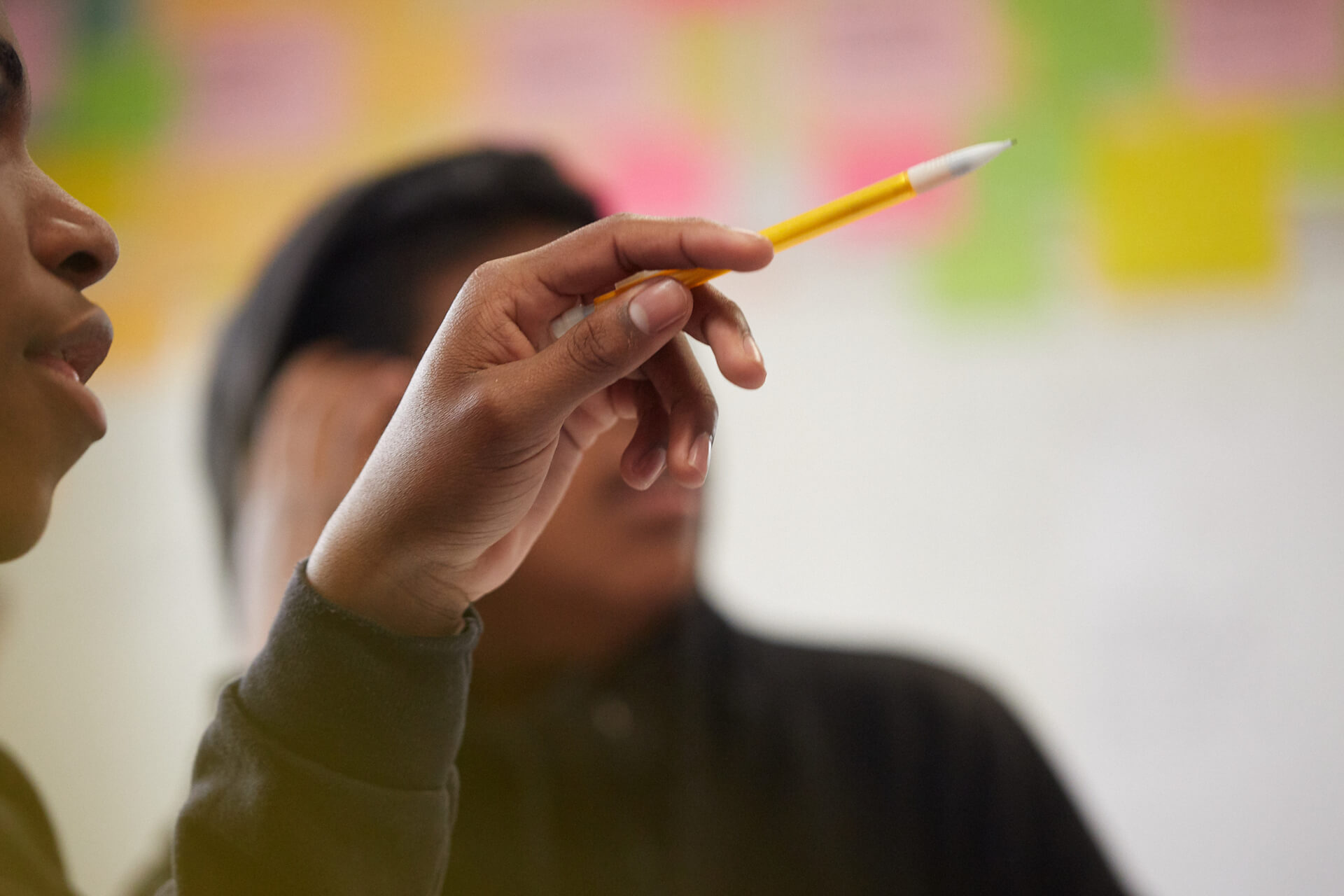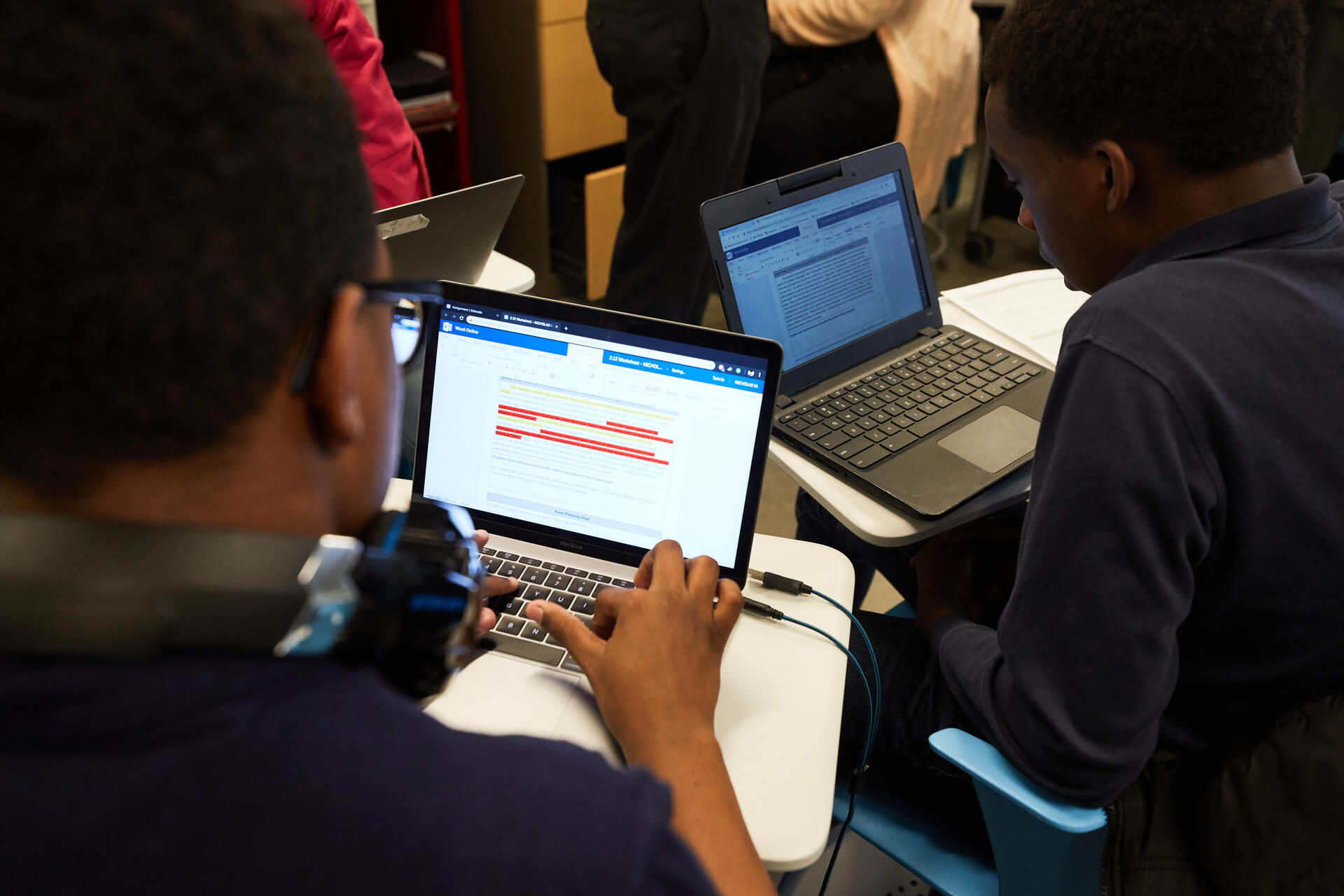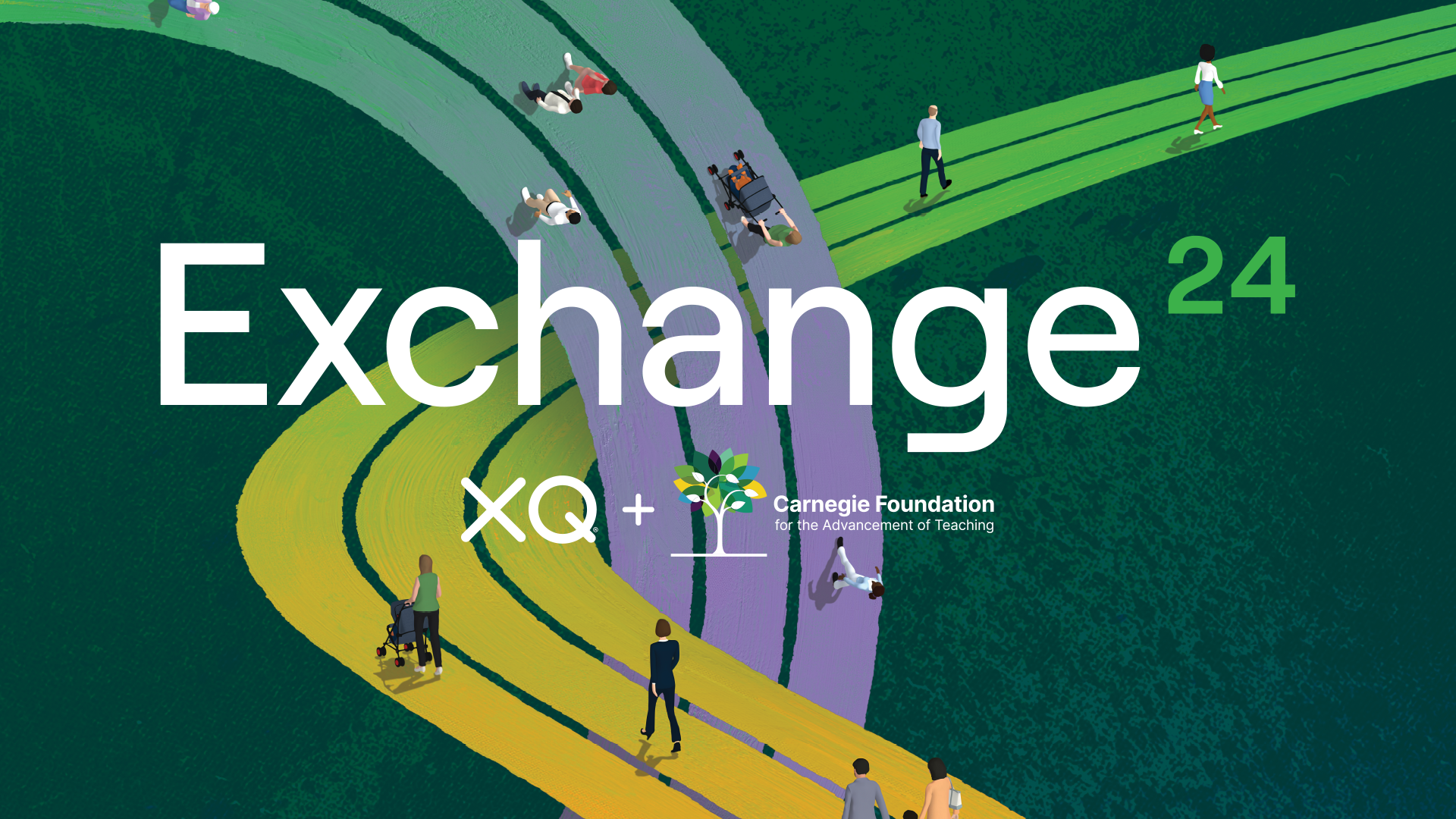Teaching High School Students To Be Critical Readers
At XQ schools, we’re redesigning high school to provide students the experiences and skills for…

At XQ schools, we’re redesigning high school to provide students the experiences and skills for them to deeply engage in their own learning and to prepare for an uncertain future. One of our five Learner Outcomes is to become original thinkers who can ask questions to make sense of the world and reframe problems to imagine creative solutions. But to do that, students first must learn how to become critical thinkers.
Critical thinking starts with critical reading. By learning to ask questions and engage more deeply with the texts they read in school, students will gain lifelong skills that will help them think more analytically about the world around them.
What is critical reading?
According to TeachThought University author and founder Terry Heick, critical reading is “reading with the purpose of critical examination of the text and its implicit and explicit themes and ideas.”
Put another way, critical reading asks students to not just absorb the words on the page but to interact with them and engage in a conversation with an author by asking questions, interrogating ideas, and dissecting arguments.
As professor and author Dan Kurland writes, critical reading is an “analytic activity.” Critical readers must ask not only what a text says, “but also how that text portrays the subject matter,” recognizing “the various ways in which each and every text is the unique creation of a unique author.”
One easy way to tell if a student is reading a text critically is to look at the condition of whatever they are reading. Are the pages dogeared? Are passages underlined or highlighted? Are there notes in the margins? If the answer is yes, that means your student is an active reader as opposed to a passive reader who simply reads the words on a page without actually digesting the ideas.
But just because a book is marked up doesn’t automatically mean a student has read it critically. Check out the notes in the margin. Some might share agreement with a passage or a quote, while others might ask questions. Others might disagree entirely with the author’s ideas. That’s the kind of engagement that is the sign of a critical reader.
How Is Critical Reading Different From Other Types of Reading?
When a student simply reads, they get a basic understanding of the text, absorbing key facts, and generally assuming that the author is correct in whatever argument they make. Critical reading asks students for deeper and more complex engagement.
In critical reading, students are taking the next step by asking what a text means more than just what it says, and making judgments of their own, questioning an author’s assumptions through a process of analyzing and evaluating, as stated in this handout from the Writing Centre at the University of Toronto.
When readers analyze, they look for the text’s main idea, or thesis; they identify supporting arguments; and they recognize the evidence used to make those arguments. When readers evaluate, they assess the strength of an author’s evidence and the credibility of sources, and whether the arguments used to support a thesis make logical sense.
Types of reading
How a student reads depends on what that student is reading, and different texts require different skills. It’s the difference between reading a novel versus reading a menu.
Before students begin reading a new text, they might need to read for understanding to get a general idea of what they are about to dive into. Students can quickly preview the text by skimming, not reading every word but focusing on important parts, like headings, bolded words and passages, and introductory sentences.
In other cases, students will be reading for information. Say they are trying to find the date of the Battle of Gettysburg. Here, students would do best to scan a text, reading rapidly and honing in on important words to find specific facts.
When students need to read more carefully, say when doing research for an essay, they should actively read a text, most likely multiple times, apply prior knowledge, and ask questions. This is reading for analysis, also known as reading critically.
What Is the Importance of Critical Reading?
The British philosopher Edmund Burke once said, “Reading without reflecting is like eating without digesting.” To read critically means a student will exercise their own judgment about what they are reading and not just take an author’s argument at face value.
The ability to question, ask where evidence comes from, and consider an author’s biases or agenda are crucial tools to become critical thinkers. While this is important in academics, it’s also vital for navigating the real world, where young adults are inundated with a tsunami of content from print to video, newspapers, radio, television, and the internet.
Being a critical reader and thinker is also an essential part of being a discerning citizen of a democratic society. Media literacy is seen as an essential 21st-century skill. Teaching high school students to read critically will prepare them for a lifetime of thoughtful inquiry and empower them to make smart choices about what they listen to, read, and watch.
Benefits of critical reading skills
In addition to leading to better critical thinking skills and to becoming more discerning adults, research has shown that learning to read critically can improve academic success. Critical reading also comes with other benefits for students.
- Mental development: We know that the benefits of reading begin at an early age, increasing future academic achievement. But even for high school students, learning to read critically continues to help exercise the brain. More areas of the brain are engaged when they’re involved in this type of reading.
- Better academic success: It goes without saying, but by reading more critically, students will better understand what they read since they’ll have to move beyond simply scanning or skimming the text. In turn, students will remember more of what they read because they often must go over the same text multiple times.
- Better logical and problem-solving skills: Critical reading is a mental exercise. Just like running or lifting weights, this exercise strengthens the mind, leading to improved decision-making, attention to logic, and even the ability to solve problems faster.

Do Your Students Read Critically?
As a teacher, it’s essential to explicitly explain what you mean by critical reading to your students. Some might think they are critical readers because they mark up the text, while others may have no idea what the term means. It’s also helpful to explain to students why critical reading is valuable and show how those analytical skills will benefit them in the real world.
Modeling how to read critically is also important, starting with asking questions. But how do you know the right ones? Consider these three stages, each with a number of questions to model for your students to ask.
In the first phase, students will preread by scanning the text to glean some important information about what they are about to read. Questions to ask themselves include:
- Who is the author?
- Who is the publisher?
- When was the text published?
- Does the author include their references or a bibliography?
Once they answer those questions, they can begin to actually read the text. Questions students can take note of during this phase include:
- Who is the audience the author is writing for?
- What are the author’s main arguments?
- Does evidence support the author’s conclusions?
- Does the author present any counterarguments?
Finally, students can form an evaluation of what they have read. Some questions to help guide their evaluation include:
- Can you summarize in a few sentences what you read?
- How would you respond if someone asked how you liked what you read?
How to assess critical reading skills in your students
One way to help improve your student’s critical reading skills is through a method called SQ3R, which stands for “Survey, Question, Read, Recite, Review.” Developed in the late 1940s for college students, it is still an effective and valuable method for students from middle school through high school.
Students can work on reading passages utilizing the SQ3R method to hone their active and critical reading skills before diving into longer texts.
The Five Steps of SQ3R
Survey: Have students begin by glancing through a passage, making note of headings, the first sentences of paragraphs, and any pictures, graphs, charts, or other visual components. This step should only take a minute or two.
Question: Have students ask themselves questions to get them excited about what they are reading, such as “What was the passage about?” and “What do I already know about the subject?”
Read: Now, students will read the entire passage, trying to answer questions from the previous step while also underlining or circling the main idea, key arguments, and important words. They will also make notes in the margin where they agree, disagree, or are confused.
Recite: The fourth and perhaps most crucial step is to have students say what each paragraph is about in their own words. If students can summarize the main idea using their own words, it will help them better understand what they have read.
Review: Similar to Recite, students now put into their own words what the entire text was about, again, using their own words.
Teaching Critical Reading in the High School Classroom
Educators can help their students make critical reading a “habit of mind” by teaching them to develop the appropriate skills and strategies to read with a critical eye.
Before diving deaper into critical reading strategies, it’s important to remember some of the foundational skills necessary for building and supporting reading fluency in students at the high school level. To read critically, students have to develop their comprehension skills—their ability to understand and build inferences from a text. Comprehension is further supported by reading fluency, which refers to the student’s ability to read words accurately, with appropriate speed, and to identify the proper expression of words.
Students who struggle with comprehension benefit from reading fluency exercises. Read alouds, context clues, and vocabulary are incredibly valuable skillsets for high school students to help build their literacy skills. Read alouds support phonemic awareness, which then improves reading accuracy. Context clues allow students to decipher unfamiliar words, infer new meaning, and identify proper expression. Further, context clues help build vocabulary, which also builds reading speed and comprehension overall.
Teachers can further reinforce reading fluency skills by integrating low-stake annotation goals into their critical reading activities (below for more on that).
Critical reading objectives
As students begin to read critically, there are several objectives for them beyond just finishing the text. These include:
- Reading for understanding
- Recognizing arguments
- Understanding an author’s main idea (or position) and supporting details (or evidence)
- Evaluating an author’s use of evidence to support a position
Before they even begin reading, students should start by asking questions to help them think critically, like “why did my teacher ask me to read this?” and “what do I already know about this subject?” Most high school students learn rhetorical topics in their ninth and tenth-grade years. Metacognitive questions—like those cited above—mirror those rhetorical standards and can help students reach a higher proficiency level.
After reading the text, students can ask questions to begin to understand it and reflect on the author’s ideas and arguments. What is the author’s main point? Can I summarize the text in three or four sentences? Do any of the ideas in the text relate to anything else I’ve read or discussed before? Many reading standards involve building proficiency in comprehension. This line of questioning helps to reinforce reading comprehension for students, building on their overall fluency skills.
Examples of Critical Reading Skills
To go beyond just remembering an author’s argument, students need various strategies and skills to engage critically with a text. Some of these include:
Annotate: When students annotate a text, they underline important sections, like the author’s thesis statement and topic sentences of the main paragraphs. Annotation also includes adding comments and questions or symbols, like stars or happy faces, beside key passages or quotes.
Contextualize: When reading critically, students should think about the broader context of a text. When was it written? What was happening during that time of history? What were the author’s own biases and beliefs? By reflecting on these contexts, students can better reflect on their own judgment of the text.
Outline: Outlining allows students to break a large text down into its most important parts, including the main ideas and supporting evidence, in their own words.
Evaluate: Once students identify the main arguments of a text, they can break those arguments into two parts: claim and support. Students then can evaluate whether the author has made an argument that is logical, consistent, and believable.
Compare and Contrast: Students will often encounter similar ideas approached in different ways by different authors. Placing the text they read in the context of other texts, and analyzing how they are similar and different, can help with student understanding.
Steps Teachers Can Take to Foster Critical Reading
Reading critically requires a more attention from students than when they read for pleasure or for information. In the latter, they might skim, scan, or skip over unfamiliar words or ideas. But students must read the entire text to engage with it critically.
There are a number of steps teachers can help their students follow to ensure they are reading critically. These include:
- Read normally: When starting with a text, have students read through a paragraph to get a sense of what they are reading by skimming it.
- Read again: This time, students will read the same paragraph, only more carefully, reading every word and paying attention to main ideas and other important details.
- Read actively: Now, students should begin employing active reading strategies. These include underlining important sentences, writing notes, reactions, and questions in the margin, and making other marks like stars and happy or sad faces.
- Read to understand: Were there any words your students didn’t know? Any historical people or concepts they were unfamiliar with? After noting these areas, students should look up definitions or do research for context.
- Read to challenge: Once students understand a text, they should now begin to wrestle with it. Are there ideas they agree or disagree with? Is there evidence they think is valid or not? This is when students can begin to draw their own conclusions and determine how much of the author’s argument they believe or not.
- Read a variety: Be flexible about the genres, formats, and styles students read and engage with. Print, digital, and visual literacy skills transfer well amongst each other, especially as students will interact with a variety of content throughout their lives. It is crucial for students to adapt quickly and consistently, regardless format.
Conclusion
Whether reading a novel, a textbook, or a website, students must learn the skills and strategies to be active, critical readers. Rather than passively accepting an author’s ideas and arguments, they must ask questions. Through this lens, students can make more discerning evaluations, a crucial step in developing their own ideas and opinions.
Working with your students to show them how to engage with a text by asking questions, evaluating evidence, and forming their own opinions will positively affect their critical reading and thinking long after high school.
Additional Resources:
- Critical reading strategies from Brown University
- Close and critical reading strategies from Learning for Justice
- Critical reading exercises from Unify High School
- Why Is Media Literacy Important, Especially in the Wake of COVID-19?
Learn more about how XQ schools and partners are rethinking high school for all learners at xqstaging.wpengine.com and join the conversation on social media using #RethinkHighSchool.
Top Photo by Gary Askew









